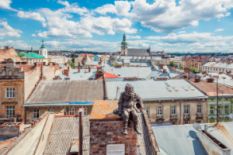The Golden Horseshoe tour of Lviv Region takes visitors to three castles – Zolochiv, Pidhirtsi and Olesko.
Zolochiv Castle
Zolochiv Castle located 70 km away from Lviv is a real pearl. This fortified outpost on the way to Lviv dates back to the 17th century. Thanks to its geographical position, it has always had an important historical significance. The fortress standing at the intersection of roads leading to Lviv repeatedly repelled attacks by Tatars and Turks, was destroyed and restored time and time again. The stone castle was built at the expense of Jakub Sobieski, the father of King of Poland John III Sobieski. It was designed by the best architects who skillfully combined different architectural styles and the latest technology of the time.The history of the castle, like a human life, has had its light and dark pages. Since 1737, the castle has been changing hands, with many of its masters denying it proper care. The walls of the castle saw a lot of human suffering and grief: there was a court and a prison with torture rooms during the Hungarian Empire, and a German Nazi HQ during World War II. The castle continued to be used as a jail under the Soviet rule. It was not until 1953 that the castle became home to a vocational school. When the Lviv Art Gallery took over the landmark in 1980s, restoration works began.
In the summer of 2004, the Chinese Palace introduced an exhibition of oriental art, tea ceremonies and knight tournaments. A collection of European art is on display in the main castle building.
Olesko Castle
This giant was built in the 14th century when the Kievan Rus was falling apart. The first written record of it dates back to 1327. Later the castle passed into the hands of kings, first to King of Poland Casimir III in 1366, and after his death to King of Poland and Hungary Louis I. At the time, local residents were forcibly turned into Catholics and the transfer of the castle into the possession of the Catholic archbishop prompted them to put up fierce resistance. In the second half of the 15th century, the locals hid behind its walls from Tatar raids. Because the castle stood close to the Kuchmanskyy salt road to Volyn, crafts and trade began to develop in the town. In 1605, the castle passed into the hands of local magnate Danylovych, who spared no efforts and money to have it rebuilt.Fifteen years later, the true palace emerged. In 1627, Ivan Danylovych held a lavish party for his daughter's wedding with Jakub Sobieski in the Olesko Castle. Shortly afterwards, in 1629, the young couple welcomed their first baby, future King John III. According to the legend, on the night John was born, the castle was repelling a Tatar attack amid a rocking thunderstorm and flashes of lightning. As soon as a midwife put the baby on the marble table, it cracked either because of a lightning strike or because the future ruler was extra mighty or had a special blessing. For centuries, the castle witnessed the ups and downs of its most powerful owners.
Pidhirtsi Castle
In the 15th and 16th centuries, a fortification was built on the land belonging to the Pidhoretski family, preceding the construction of a castle. The history of the castle in its present shape began in 1633, when this estate was bought by famous historical figure, Polish military commander Stanislaw Koniecpolski. The castle was designed by Italian architects as a "palazzo in fortezza" (a palace in a fortress). Expensive types of wood, dark marble and gilding were used to decorate its interior.The castle was surrounded by an Italian park with fountains, sculptures and rare plants, as well as vineyards for the development of local winemaking. In 1648, the castle experienced a rough patch. The Cossacks attacked the castle on more than one occasion during Hetman Bogdan Khmelnytskyy's uprising. One of Koniecpolski's descendants decided to restore the castle in 1656. After he died in 1682, it became a property of King John III Sobieski, who also owned Zolochiv Castle. After the death of the king, the castle repeatedly changed hands and had a lot of different owners...
Photos: shutterstock.com. All images belong to their rightful authors.

















